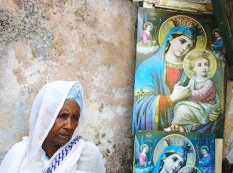Ethiopian monastery in Jerusalem’s Old City
 The Ethiopians have no property in the Church of the Holy Sepulcher, only access rights; but they do have a little monastery nearby, known as Deir es-Sultan, that is worth a visit.
The Ethiopians have no property in the Church of the Holy Sepulcher, only access rights; but they do have a little monastery nearby, known as Deir es-Sultan, that is worth a visit.
Jerusalem speaks with many voices, and in a babble of tongues. Nowhere is this more in evidence than the Church of the Holy Sepulcher, in the heart of the Old City’s Christian Quarter. The cavernous medieval structure stands, it is believed, where Jesus was crucified and buried. It is shared today – unequally and uneasily – by several Christian denominations (none of them Protestant). The Greek Orthodox are the major “shareholders,†followed by the Roman Catholics (“Latinsâ€Â), Armenian Orthodox, Copts (Egyptian) and the marginalized Syriac Orthodox.
The Ethiopians have no property in the Holy Sepulcher, only access rights; but they have a little monastery, known as Deir es-Sultan, on the roof of a medieval annex. The entrance to the compound is from the Ninth Station of the Cross, up a slightly obscured stairway off Suq Khan e-Zeit, the artery of the Arab market that slices from the Damascus Gate toward the Jewish Quarter. If you can spot a sign on the street leading up to Mike’s Center, a hole-in-the-wall Internet café halfway up the stairway, you’re home free.
Step into the Ethiopian courtyard opposite the Coptic monastery. A weeping willow (rather symbolically) casts some shade across the bare stones, where a defunct water pump, ruined Gothic arches and tiny monks’ cells cower under a skyline of rival crosses. The Ethiopian church has known better days: it lost its lands in a Marxist coup in the 1970s, and the gentle monks sent to the holy city live quietly in scriptural poverty. Read more



